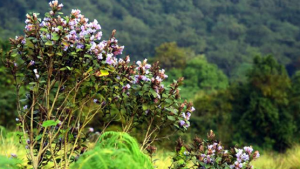TAG: GS 3: ECOLOGY AND ENVIRONMENT
THE CONTEXT: Neelakurinji (Strobilanthes kunthiana), a unique and rare flowering shrub known for its mass blooming every 12 years in the Western Ghats, has been officially classified as a threatened species.
EXPLANATION:
- This assessment marks the first time that Neelakurinji has been evaluated against the International Union for Conservation of Nature (IUCN) global standards, confirming its status as vulnerable under the IUCN’s Red List Criteria A2c.
Neelakurinji
- Neelakurinji is a purplish-blue flowering shrub that grows to about three meters in height.
- It is endemic to the high-altitude shola grassland ecosystems of the Western Ghats.
- The shrub blooms synchronously once in 12 years, covering the montane grasslands in a breathtaking blanket of blue-purple flowers.
- This rare phenomenon has been documented since 1832 and has become a significant tourist attraction, drawing visitors from around the world to witness the spectacle.
- The shrub is semelparous, meaning it flowers and fruits only once in its lifetime, after which it dies.
- The blooming typically occurs at elevations ranging from 1,340 to 2,600 meters, making these montane grasslands, often referred to as “sky islands,” crucial habitats for the species.

The Delay in Global Recognition and Assessment
- Although Neelakurinji was long considered threatened, it had not been formally assessed against IUCN global standards until recently.
- The recent assessment was conducted by the Centre for Ecology Taxonomy Conservation and Climate Change (CEtC) of the Western Ghats Hornbill Foundation at MES Asmabi College, Kodungalloor, and reviewed by the Western Ghats Plant Specialist Group.
- The delay in the formal assessment was largely due to the species’ unique blooming cycle, its limited distribution across the Western Ghats, and the lack of comprehensive ecological studies.
- The recent evaluation has now provided a much-needed global perspective on the species’ conservation status.
Threats Facing Neelakurinji
- Neelakurinji’s habitat in the montane grasslands of the Western Ghats is fragile and under severe threat from various human activities.
- Approximately 40% of its original habitat has already been lost, with the remaining areas facing ongoing pressures.
- These threats include the conversion of land for tea and softwood plantations, urbanization, and the invasion of exotic species such as eucalyptus and black wattle.
- Additionally, infrastructure development and afforestation programs, along with the broader impacts of climate change, pose significant risks to the survival of this species.
- The recent assessment has classified Neelakurinji as Vulnerable under IUCN Criteria A2c, which indicates a high risk of extinction due to a declining population driven by habitat loss and degradation.
Distribution and Subpopulations
- Neelakurinji’s actual area of occupancy is limited to about 220 square kilometers, with an extent of occurrence spanning 25,510 square kilometers across the high-altitude mountain ranges of southwest India.
- The species is found in 34 subpopulations within 14 ecoregions, predominantly in the Western Ghats.
- The majority of these subpopulations are concentrated in the Nilgiris of Tamil Nadu, with others in the Munnar, Palani-Kodaikanal, and Anamalai mountain ranges.
- There is also one isolated subpopulation in the Eastern Ghats, located in the Shevaroy Hills near Yercaud.
The Urgent Need for Conservation
- The inclusion of Neelakurinji on the IUCN Red List as a vulnerable species underscores the urgent need for conservation action.
- Protecting the remaining montane grassland habitats and addressing the threats posed by invasive species, land conversion, and climate change are critical for the survival of this iconic species.
- Conservation efforts must focus on habitat preservation, restoration, and the careful management of tourism to ensure that the unique ecological and cultural value of Neelakurinji is not lost to future generations.
- The global recognition of its threatened status should serve as a catalyst for both local and international conservation initiatives aimed at safeguarding this remarkable natural phenomenon.

